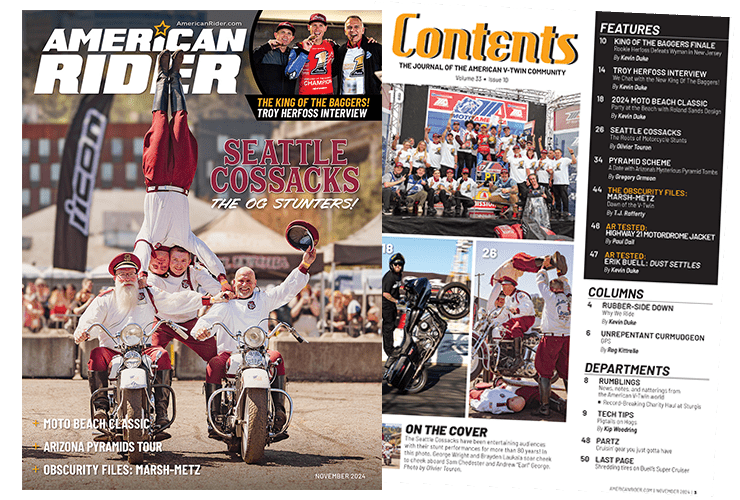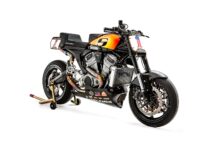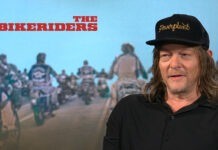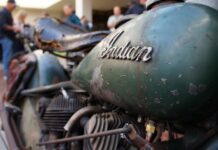As this is being written, I’m about to celebrate over 20 years with my favorite motorcycle ever. I’ve had it (or it has had me) longer than anything else! This bike has seen me through dozens of cars, as many additional motorcycles, three wives, nine jobs and uncounted adventures. Trusty at all times and uncommonly good to ride, I’m on record that I may own other machines—along with—but never instead of. You can’t sell an old friend!
And how those times have flown! The hardest thing for me to wrap my noodle around is that my Harley is now officially “old.” After all, if 105 years is ancient for a motorcycle company, a quarter of a century is primordial for a mechanical device in our fast-paced, “disposable” world. Of course, that’s why the bike is comparatively uncommon today as well. Not rare exactly, just nowhere near as plentiful as the machines that have come since. Face it, Harley has built more Twinkies than all other models combined. It got me thinking…
There’s a sort of ebb and flow to this business of building Harleys for over a century, as we are about to see.
Just to keep things somewhat manageable, there are a few ground rules to our observations. First of all, the only motorcycles included in these approximate, sorta round-number annual production figures are overhead valve V-twin models. I’ve tried to separate Big Twins from Sportsters after 1957, but that’s liable to be even more inaccurate, until 1987 when the numbers are public record. Second, the stats begin in 1936, because that was the first year of overhead valve street V-twins. Third, I’m lumping all Big Twin models together for each year.
The hope is, you’ll get something out of this exercise you may not have thought of before which will help you appreciate what the last 70-odd years have been about for this company, the riders who came before and particularly the machines… the older, the more precious. May you someday find one that you, too, will be happy with for a long, long time to come!
| Year | OHV production |
|---|---|
| 1936 | 1,704 Knuckleheads, or as officially known, 61-inch “E”-series, are launched—pretty much outta the blue. The motive, arguably, was to step H-D up to the status of Buick, Packard, and other high-end straight eights, possibly even V12 Auburns and Caddies. |
| 1937 | 2,025 Needless to say, with a 136-mph speed record under its tread, among 20-something horsepower flatheads, a 40 horsepower Knuck was the Hayabusa of the depression era, and for good reason—it had to be! |
| 1938 | 2,478 |
| 1939 | 2,909 |
| 1940 | 4,069 |
| 1941 | 5,149 The “E” becomes the first “F” as the Knuckle grows to 1200cc and assumes the mantle of a “Seventy Four” Harley. |
| 1942 | 1,743 Yup—There’s a war on! Overhead valve bikes are shunned in favor of flathead sloggers for the American War Machine, so we get about a bazillion military 45s and almost no Knucks |
| 1943 | 303 Almost no motorcycles for us, but plenty for the troops |
| 1944 | 460 |
| 1945 | 1,430 The war is over, and the “biker” as it emerged then was a vastly different animal from the one we know today |
| 1946 | 6,746 |
| 1947 | 11,648 Production doubles again and Hollister happens. The hype hits the papers, and the “biker” is no longer in the closet. Total Knucklehead production adds up to about 41,000 machines |
| 1948 | 12,924 The Panhead appears |
| 1949 | 12,685 Hydraulic forks are discovered by Harley-Davidson and added to the hydraulic lifters introduced on the Pan engine the year before |
| 1950 | 10,174 The last of the founding fathers of H-D dies in—of all things—a car crash |
| 1951 | 8,303 Indian has lost the war. Harley barely has time to get its breath and another starts—this time with the British |
| 1952 | 6,700 |
| 1953 | 5,337 The big deal for H-D this year is that it finally sells more foot-shift Big Twins than tank shifters |
| 1954 | 4,757 Harley’s whole range was getting a bit stale… no changes… nothing really new and exciting, except maybe the company’s 50th anniversary |
| 1955 | 5,142 The Motor Company decides to hot-rod the Pan a little by debuting the FLH, with 8:1 compression and polished and flowed intake ports |
| 1956 | 5,806 FLH gets hotter cams to go with all the goodies from last year’s model |
| 1957 | 8,000 (5,616 BT; 2,401 XL) Harley’s ammunition in the Brit-bike wars arrives—again—in the form of overhead valves. This time the opening salvo is the Sportster, a totally appropriate name for an all-American weapon of mass attraction |
| 1958 | 7,550 (6,038 BT; 1,529 XL) Hydraulic brakes and rear shocks appear on Big Twins |
| 1959 | 7,800 (5,767 BT; 2,061 XL) Honda Motor Co., already the biggest builder in the world at over a million tiddlers a year, starts selling in the U.S. |
| 1960 | 8,750 (5,967 BT; 2,765 XL) |
| 1961 | 6.950 (4,927 BT; 2,014 XL) |
| 1962 | 7,200 (5,184 BT; 1,998 XL) |
| 1963 | 5,700 (4,246 BT; 1,433 XL) |
| 1964 | 8,400 (5,500 BT; 2,860 XL) |
| 1965 | 10,700 (6,930 BT; 3,770 XL) Say hello to 12-volt systems and electric starters but good-bye to the Panhead. In its 17-year run a smashing total of a little over 116,000 Panheads were made |
| 1966 | 12,600 (7,800 BT; 4,800 XL) Harley’s Shovelhead breaks cover |
| 1967 | 12,250 (7,750 BT; 4,500 XL) Sportsters get electric starters as an option |
| 1968 | 13,950 (7,072 BT; 6,884 XL) |
| 1969 | 15,100 (7,300 BT; 7,800 XL) Honda delivers the unthinkable: an affordable, exotic, SOHC, disc-braked, electrically-started, 4-cylinder wonder bike. Triumph has its most profitable year in a history that dates back even further than Harley’s. AMF buys Harley-Davidson and the industry nearly turns inside out over the next decade |
| 1970 | 16,200 (7,615 BT; 8,560 XL) Harley gives Big Twins alternators instead of generators |
| 1971 | 22,150 (11,375 BT; 1,0775 XL) The first FX Harley ever, and Sportsters get a goofy wet clutch |
| 1972 | 34,350 (16,200 BT; 18,150 XL) AMF cranks up the marketing machine and production practically doubles. Sportsters grow to 1000cc (61”) and both XL and FX models can be had with or without electric starters |
| 1973 | 37,100 (16,400 BT; 20,700 XL) Without the Servicar that they quit making after 45 years |
| 1974 | 40,450 (16,500 BT; 23,830 XL) Harley, 70 years into its history, had yet to sell a million OHV machines |
| 1975 | 41,650 (22,245 BT; 19,410 XL) The parent company, to its chagrin, is learning that it’s almost impossible to maintain quality at these volumes. The Harley models AMF inherited lend themselves to slow, meticulous, laborious handwork by experienced craftsmen, not the rush-rush of a rapid assembly line |
| 1976 | 47,700 (29,586 BT; 18,082 XL) Harley builds “Liberty” editions to celebrate the Nation’s 200th B-day. Musta worked, cause this is the highest-ever production of V-twins under the AMF banner |
| 1977 | 44,250 (24,417 BT; 19,838 XL) The Low Rider and the Café Racer show up. One stays, the other disappears in no time. H-D also builds the first Electra Glide Sports model, the FLHS |
| 1978 | 46,850 (29,281 BT; 17,561 XL) Harley pulled out of the small motorcycle market, selling Aermacchi to Cagiva in Italy, but electronic ignitions and 80-inch Big Twins are the big news from Wisconsin |
| 1979 | 38,975 (37,780 BT; 11,798 XL) AMF decides that it needs new products to compete rather than just building more of the old ones, so the NOVA project is born |
| 1980 | 46,700 (31,615 BT; 14,767 XL) In spite of the money and 10 years of time invested by AMF, there’s no $70 million dollar check for the project, so Chairman Vaughn Beals recommends the company be sold. All the same, the rubber-mount FLT is born this year, as is the belt drive, but most people buy the new FXWG (Wide Glide) “factory custom” |
| 1981 | 41,600 (30,166 BT; 10,102 XL) Harley buys itself back from AMF, just in time to see a huge slump in the industry |
| 1982 | 28,000 (17,389 BT; 6,276 XL) The FXR shows up. The company gets lean and mean just in time |
| 1983 | 29,500 (13,818 BT; 8,738 XL) Harley finally gets its protective tariff against unfair practices by the Japanese competition, builds the “bike that couldn’t be built”—the XR1000—and much more importantly builds the XLX—a Sportster for $3,995 and a guaranteed trade-in value. The Harley Owner’s Group is hatched, and all this brilliance is barely enough to bump production |
| 1984 | 37,850 (30,878 BT; 6,175 XL) The Shovelhead bows out as the Evolution engine arrives in Big Twin guise along with the Softail chassis. The Motor Company starts to turn the corner (it’s hard to be sure but it appears that the Shovel accounted for over a third of the total production) Approximately 346,000 Shovelhead Big Twins are made in an 18-year run |
| 1985 | 32,300 (25,786 BT; 6,514 XL) |
| 1986 | 36,735 (24,776 BT; 11,959 XL) In the 50 years Harley-Davidson has been churning out OHV V-twins, it all amounts to 859,000 machines, give or take. Sportsters get the Evo Treatment |
| 1987 | 43,315 (29,066 BT; 14,249 XL) Big Twins are all five-speeds |
| 1988 | 50,517 (33,026 BT; 17,491 XL) Springer forks make a comeback after a 40-year hiatus |
| 1989 | 58,925 (41,087 BT; 17,838 XL) |
| 1990 | 62,458 (46,339 BT; 16,119 XL) |
| 1991 | 68,626 (49,891 BT; 18,735 XL) Sportsters get a five-speed. Dyna-Glide introduced |
| 1992 | 76,495 (58,872 BT; 17,623 XL) |
| 1993 | 81,696 (59,449 BT; 22,247 XL) H-D starts acquiring interest in Erik Buell’s motorcycles |
| 1994 | 96,387 (69,345 BT; 26,466 XL; Buell 576) FXR discontinued. New VR1000 racer races, doesn’t win. FLHR debuts—now that is a winner! |
| 1995 | 106,511 (75,479 BT; 29,625 XL; Buell 1,407) 30th Anniversary Electra-Glides get fuel injection |
| 1996 | 121,533 (87,598 BT; 31,173 XL; Buell 2,762) |
| 1997 | 136,700 (100,832 BT; 31,453 XL; Buell 4,415) |
| 1998 | 157,100 (116,926 BT; 33,892 XL; Buell 6,282) Harley-Davidson acquires controlling interest in Buell |
| 1999 | 184,954 (135,317 BT; 41,870 XL; Buell 7,767) Twin Cam Big Twin is introduced alongside the last Evo Softails. FXR does an encore. Close to 850,000 Evolution Big Twins are manufactured during the Evo’s 15-year reign. |
| 2000 | 209,635 (158,379 BT; 46,213 XL; Buell 5,043 [no Blast singles included]) Twin Cam Softails get counter-balanced engines |
| 2001 | 240,416 (183,647 BT; 50,814 XL; Buell 5,955) VR1000 killed. V-Rod born |
| 2002 | 273,233 (194,474 BT; V-Rod 19,709; 51,171 XL; Buell 7,879) |
| 2003 | 301,000 (233,982 BT inc. V-Rod; 57,165 XL; Buell 7,979) |
| 2004 | 325,667 (247,468 BT inc. V-Rod; 69,821 XL; Buell 8,378) Sportsters get rubber-mounted engines and all-new chassis |
| 2005 | 337,783 (258,802 BT inc. V-Rod; 70,215 XL; Buell 8,766) |
| 2006 | 359,413 (284,639 BT inc. V-Rod; 64,557 XL; Buell 10,217) Dyna models get six-speeds and carburetors go extinct. |
| 2007 | 340,059 (258,583 BT inc. V-Rod; 72,036 XL; Buell 9,440) Twin Cam grows to 96-inches and all Big Twins are six-shooters. |
| 2008 | 312,674 (242,795 BT inc. V-Rod; 60,684 XL; Buell 9,195) Buell introduces the first model without a Harley-based engine, the 1125R. Harley buys another Italian motorcycle manufacturer! |
| 2009 | (TBD) Production is down for obvious reasons |
However, in a mere decade of on-going production, the Twin Cam “field population” already exceeds the totals of all previous Harley OHV Big Twins combined—nearly 1,750,000 and counting!
Figuring out a realistic attrition rate for these machines over seven decades is virtually impossible. Adding accurate numbers of “clones” to the mix only makes the notion tougher yet. Even if every OHV H-D ever built was still around, with over six billion people on this planet, only about one in 2,000 will ever have the chance to cherish a hog. Aren’t we the lucky ones?




















Thanks for the production numbers on the bikes. This was probably a huge undertaking to get this info. Do you have the rest of the production numbers for the Twin Cam for 209 – 2012 when I believe it was no longer produced?
Thank you, Colleen A. Johnson,
What an undertaking. I thank you. Randy W. Click